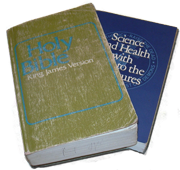Which book is of God, hers or his?
Mary Baker Eddy invites us to put her and her book to the test, “and so ascertain if the author has given you the correct interpretation of Scripture” (Science and Health, 547:7). We should do just that, with our eyes wide open to the divergence
between the two books at many points. Either Science and Health must correct the Bible, or the Bible must correct Eddy’s textbook. They can’t both be true throughout.
Studying today in Paul’s letter to the Galatians, which has been called the first autobiography of a Christian convert, I noticed that some verses in the first chapter rang a bell from my years of following Mrs. Eddy until well into my 40s. The verses were these:
“I certify you, brethren, that the gospel which is preached of me is not after man, for I neither received it of man, neither was I taught it, but by the revelation of Jesus Christ…. But when it pleased God, who separated me from my mother’s womb, and called me by his grace, to reveal his Son in me, that I might preach him among the heathen, immediately I conferred not with flesh and blood” (Galatians 1:11, 12, 15, 16).
After a bit of digging, I found the first two verses quoted verbatim on S&H 107 as an epigraph to her chapter on “Science, Theology, and Medicine,” and the other two quoted in part on S&H 478, in her “Recapitulation” chapter — which we’re told grew out of an early writing that became the nucleus of her entire textbook as now received (see S&H 465).
Significantly and typically, in citing Galatians 1:15, 16, Eddy omits Paul’s key thought beginning at “to reveal” and ending at “heathen,” thus obscuring his Christological point in order to make her own epistemological point about the question at hand, “is there intelligence in matter?”
Her answer to that question occupies the next several pages, a thousand words or so, and quotes the New Testament three more times, all without ever once mentioning Jesus or Christ. Such proof-texting, always to the detriment of our Lord’s true identity and work, is sadly typical of Science and Health from beginning to end.
As for Eddy’s initial citation from this important passage in Galatians, verses 1:11 and 1:12, one marvels at the presumptuousness of an author who could claim to be preaching the identical gospel that Paul did, a message allegedly taught to her (as it had been to him) “by the revelation of Jesus Christ” — and who yet could build her whole book and system on deconstructing every element of Paul’s core message “that Christ died for our sins according to the Scriptures” (I Cor. 15:3).
Here permit me an autobiographical aside of my own: A breakthrough in my reassessment of the claims of Christian Science occurred when the challenge of serving as a reader in our branch church prompted me to start reading the Bible chapter by chapter instead of “lesson sermon style,” verse by verse.
One eye-opener was noticing how the blue-chalk residue on so many pages tended to color the same few passages, effectively walling off the compliant CS student from vast parts of God’s word in Scripture.
Another eye-opener was realizing how frequently the context of a chapter in its entirety (especially in the New Testament) would redirect — or sometimes even reverse — the implication of some shorter passage the lessons or periodicals had lifted out of context and misleadingly presented as “truth.”
Again and again, that redirection took the form of impressing on me the very gospel Paul summarizes in his great Corinthians declaration quoted above: that I was a sinner in need of a Savior, that his name was Jesus, and that we must accept no substitutes.
I mention this because the warning to accept no substitutes is exactly what we find in reading the whole chapter in the case of Galatians 1.
Backing up from verse 11, in which Mrs. Eddy dishonestly (there is no gentler way to put it) wraps herself on S&H 107, what do we encounter? This emphatic statement in verse 8:
“Though we, or an angel from heaven, preach any other gospel unto you than that which we have preached unto you, let him be accursed.”
It couldn’t be any clearer — and it couldn’t reflect any more unfavorably on Mrs. Eddy, by whom so many of us were taught that we’re not really sinners, Jesus isn’t really God, he didn’t really die on the cross, the Bible isn’t really inerrant, and so much more.
I will stop there. But notice how many other lines of inquiry abound from these conflicting passages in Jesus’ book, the Bible, and Eddy’s book, Science and Health.
** We could ask, apropos Galatians 1:6, how so many Christians who should have known better were lured away from the grace of Christ into the self-salvation of CS from the 1870s down to the 1930s and beyond.
** We could ask, apropos Galatians 1:10, how much of that allure was a matter of men-pleasing in the form of a) flattery cooing “you’re perfect” and b) creature comforts promising “you’re healed.”
** We could ask, apropos the first eight lines of S&H 547, by what leap of logic anyone can claim that a) the airtight coherence of every statement in the textbook, and b) the monopolistic superiority of Eddyism over any other kind of Christian prayer, are both “proved” by those scattered healings that result from CS prayer.
All this we can take up some other time. For now, we should end as we began: by facing squarely the impossibility that both the Bible and Science and Health, his book and hers, can be all true — since they explicitly contradict each other.
Only one of the two books can be of God. Not both. My vote is with Holy Scripture.
The author can be reached at andrewsjk@aol.com

